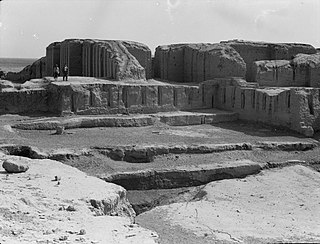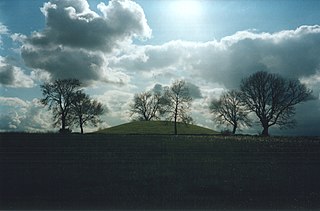
Lughnasadh or Lughnasa is a Gaelic festival marking the beginning of the harvest season. Historically, it was widely observed throughout Ireland, Scotland and the Isle of Man. In Modern Irish it is called Lúnasa, in Scottish Gaelic: Lùnastal, and in Manx: Luanistyn. Traditionally it is held on 1 August, or about halfway between the summer solstice and autumn equinox. In recent centuries some of the celebrations have been shifted to the Sunday nearest this date.
Tailtiu or Tailltiu is the name of a presumed goddess from Irish mythology. The goddess's name is linked to Teltown in Co. Meath, site of the Óenach Tailten. A legendary dindsenchas "lore of places" poem relates a myth connecting the presumed goddess Tailtiu with the site. However, linguistic analysis of the name reveals that Tailtiu as a place-name derives from a loan word of Brythonic origin represented by the Welsh telediw "well formed, beautiful." The mythological character of Tailtiu likely derives her name from the place-name.

Kish is an important archaeological site in Babil Governorate (Iraq). It was occupied from the Ubaid to Hellenistic periods.

The Hill of Tara is a hill and ancient ceremonial and burial site near Skryne in County Meath, Ireland. Tradition identifies the hill as the inauguration place and seat of the High Kings of Ireland; it also appears in Irish mythology. Tara consists of numerous monuments and earthworks—dating from the Neolithic to the Iron Age—including a passage tomb, burial mounds, round enclosures, a standing stone, and a ceremonial avenue. There is also a church and graveyard on the hill. Tara forms part of a larger ancient landscape and Tara itself is a protected national monument under the care of the Office of Public Works, an agency of the Irish Government.

Rathcroghan is a complex of archaeological sites near Tulsk in County Roscommon, Ireland. It is identified as the site of Cruachan, the traditional capital of the Connachta, the prehistoric and early historic rulers of the western territory. The Rathcroghan Complex is a unique archaeological landscape with many references found in early Irish medieval manuscripts.

Ringforts, ring forts or ring fortresses are circular fortified settlements that were mostly built during the Bronze Age up to about the year 1000. They are found in Northern Europe, especially in Ireland. There are also many in South Wales and in Cornwall, where they are called rounds. Ringforts come in many sizes and may be made of stone or earth. Earthen ringforts would have been marked by a circular rampart, often with a stakewall. Both stone and earthen ringforts would generally have had at least one building inside.

Navan Fort is an ancient ceremonial monument near Armagh, Northern Ireland. According to tradition it was one of the great royal sites of pre-Christian Gaelic Ireland and the capital of the Ulaidh. It is a large circular hilltop enclosure—marked by a bank and ditch—inside which is a circular mound and the remains of a ring barrow. Archeological investigations show that there were once buildings on the site, including a huge roundhouse-like structure that has been likened to a temple. In a ritual act, this timber structure was filled with stones, deliberately burnt down and then covered with earth to create the mound which stands today. It is believed that Navan was a pagan ceremonial site and was regarded as a sacred space. It features prominently in Irish mythology, especially in the tales of the Ulster Cycle. According to the Oxford Dictionary of Celtic Mythology, "the [Eamhain Mhacha] of myth and legend is a far grander and mysterious place than archeological excavation supports".

A number of pre-Columbian cultures are collectively termed "Mound Builders". The term does not refer to a specific people or archaeological culture, but refers to the characteristic mound earthworks erected for an extended period of more than 5,000 years. The "Mound Builder" cultures span the period of roughly 3500 BCE to the 16th century CE, including the Archaic period, Woodland period, and Mississippian period. Geographically, the cultures were present in the region of the Great Lakes, the Ohio River Valley, and the Mississippi River valley and its tributary waters.
Páirc Tailteann is a GAA stadium in Navan, County Meath, Ireland. It is the home of the Meath Gaelic football and Hurling teams. The ground has had a capacity of between 30,000 and 33,000, but following a safety audit in 2011 the GAA reduced the authorized capacity to 10,000. This was later upped to 17,000. The county board in 2012 announced plans to refurbish the grounds. In 2013 Meath county board introduced a ticket system The name "Tailteann" alludes to the Tailteann Games, an ancient Gaelic festival held in Teltown between Navan and Kells.
The Tailteann Games, Tailtin Fair, Áenach Tailteann, Aonach Tailteann, Assembly of Talti, Fair of Taltiu or Festival of Taltii were funeral games associated with the semi-legendary history of Pre-Christian Ireland.

Groby Castle is situated in the large village of Groby to the north-west of the city of Leicester.

In archaeology, earthworks are artificial changes in land level, typically made from piles of artificially placed or sculpted rocks and soil. Earthworks can themselves be archaeological features, or they can show features beneath the surface.

Pilsbury Castle was a Norman castle in Derbyshire near the present-day village of Pilsbury, overlooking the River Dove.
An aonach or óenach was an ancient Irish public national assembly called upon the death of a king, queen, or notable sage or warrior as part of ancestor worship practices. As well as the entertainment, the óenach was an occasion on which kings and notables met under truce and where laws were pronounced and confirmed.

The royal sites of Ireland were the seats of the Gaelic kings of Ireland. Medieval sources describe them as the ceremonial capitals of various Irish kingdoms, where kingly inaugurations, assemblies and athletic games were held. Archaeological investigations show that many royal sites were culturally significant for thousands of years before recorded history, and they often include ancient monuments such as Neolithic burial mounds, standing stones, cairns and enclosures.

Poverty Point State Historic Site/Poverty Point National Monument is a prehistoric earthwork constructed by the Poverty Point culture. The Poverty Point site is located in present-day northeastern Louisiana though evidence of the Poverty Point culture extends throughout much of the Southeastern Woodlands. The culture extended 100 miles (160 km) across the Mississippi Delta and south to the Gulf Coast. The Poverty Point site has been designated as a state historic site, U.S. National Monument, a U.S. National Historic Landmark, and UNESCO World Heritage Site. Located in the Southern United States, the site is 15.5 miles (24.9 km) from the current flow of the Mississippi River, and is situated on the edge of Macon Ridge, near the village of Epps in West Carroll Parish, Louisiana.
Funeral games are athletic competitions held in honor of a recently deceased person. The celebration of funeral games was common to a number of ancient civilizations. Athletics and games such as wrestling are depicted on Sumerian statues dating from approximately 2600 BC, and funeral games are depicted in early Greek vases, such as the Francois vase at Florence and the Amphiaraus vase in Berlin. In some accounts, funeral games were not merely held to honor the deceased, but in order to propitiate the spirits of those who had died.
Indian Mound Reserve is a public country park near the village of Cedarville, Ohio, United States. Named for two different earthworks within its bounds — the Williamson Mound and the Pollock Works — the park straddles Massies Creek as it flows through a small canyon.

The Tailteann Games or Aonach Tailteann was an Irish sporting and cultural festival held in the Irish Free State in 1924, 1928, and 1932. It was intended as a modern revival of the Tailteann Games held from legendary times until the Norman invasion of Ireland; as such it drew inspiration from the Modern Olympics revival of the Ancient Olympics. Croke Park, the Dublin headquarters of the Gaelic Athletic Association, was the venue for the opening ceremony and many of the sports events, which were open to people of Irish birth or ancestry. The Tailteann Games were held shortly after the Summer Olympics, such that athletes participating in Paris 1924 and Amsterdam 1928 came to compete. Participants coming from England, Scotland, Wales, Canada, the USA, South Africa and Australia as well as Ireland. Chess competitions were held in conjunction with the Irish Chess Union as part of the Tailteann Games. There were also artistic competitions and industrial displays. The games became regarded as a Cumann na nGaedheal project, and when that party lost power to Fianna Fáil after the 1932 election there was no financial backing for further games.












